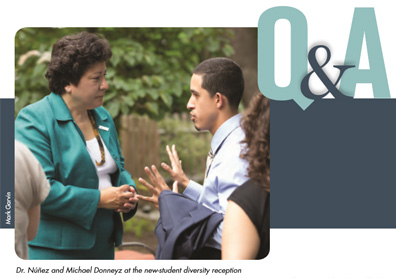Q&A with Ana Núñez, MD

Ana E. Núñez, MD, was appointed to the newly created position of associate dean for diversity, equity and inclusion for the College of Medicine and the College's Graduate School of Biomedical Sciences and Professional Studies in April 2016. She also directs the Center of Excellence in Women's Health and the Women's Health Education Program at the College of Medicine. Núñez is a nationally recognized medical education leader in women's health, curricular reform and cultural competency.
WHAT ARE YOUR OVERALL GOALS for diversity, equity and inclusion?
Diversity, equity and inclusion doesn't happen just for its sake alone. It's how we achieve excellence in our mission as a College. We're about being great teachers, great doctors and great researchers, and training people to continue in that path. In doing so, we must be mindful of the diverse populations on our campuses, address issues of unconscious bias, and make sure that everyone is in a place to be able to learn and participate fully, and achieve excellent educational outcomes.
HOW WILL YOU ACHIEVE these goals?
My job is to promote measureable organizational change. That happens by integrating all facets of the organization for all stakeholders. It means working with others across the continuum — from recruitment and retention to promotion. My goal is to eliminate silos and introduce people working on similar efforts. We will have a much bigger impact and make faster progress as we work together.
WHAT INITIATIVES are you working on?
Building a model of diversity, equity and inclusion is a long-term initiative that requires many short- and medium-term initiatives and interventions. Building upon the new holistic review and recruitment for medical school applicants, our charge from the Dean was to address the lack of black men in medicine. I have convened internal and external advisory groups to help strategize solutions. We are also creating Diversity Action Councils with diverse representation. This will enable us to have cross-cutting information about what's happening in different areas of the College and Graduate School. St. Christopher's, for example, is spearheading Diversity Grand Rounds. In resident education, new wellness events have been developed. We are also reformulating our faculty Committee for Diversity and Inclusive Excellence to engage current and new members.
Pipeline programs that support enrollment into the College are important. Our unique Drexel Pathway to Medical School affords underrepresented students enrichment for future success and a guaranteed seat in the class. This Graduate School program is being evaluated to enhance our impact as a "college of opportunity," a goal that is very important to Dr. Schidlow.
Another initiative is bias-mitigation training, including a program for faculty search committees, admissions committees and resident workshops. Training raises awareness of unconscious bias related to gender, ethnicity and LGBT status, and develops our skills to help each other minimize its unintentional impact, thus ensuring that we invite the most talented individuals to join our ranks.
The office works to build community. We sponsor events that involve outreach to students, including racial and ethnic minorities as well as LGBT people. And we promote greater awareness of the rich diversity of the College by celebrating diversity.
Our office is unique in that we include sex and gender health equity. I also connect individuals and groups to help address some of the national issues we face, such as the mass shooting in Orlando and the Black Lives Matter movement. We are also creating a timely and responsive web presence (drexel.edu/medicine/diversity).
HOW WILL YOU MEASURE your success?
We must ask hard questions. What is it about the individuals in our organization that lets them thrive or makes them struggle? What does our environment allow regarding inclusivity, voice, safety and respect? What do we do incredibly well and why? What do we need to change in our environment to make it more inclusive, productive, safe and respectful so more people thrive rather than struggle? We are developing metrics to highlight that change.
Back to Top